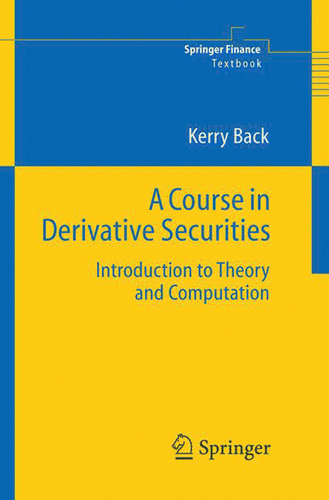
A Course in Derivative Securities: Introduction to Theory and Computation by Kerry Back, Springer, Berlin, (2005), 355 pp., $69.95, ISBN 3-540-25373-4.
This book is a textbook on the mathematics of finance with leanings towards computation and the practical application of the tools used. It is not an introduction to financial markets and practice, nor is it a complete and rigorous treatment of stochastic calculus as applied in finance: instead it is a textbook on financial engineering. The author himself calls it a cookbook approach, which is perhaps a self-denigration too far, but certainly the emphasis is on the development and application of tools, rather than formal definitions or precise statements of necessary and sufficient conditions, or indeed proofs. The methods-based philosophy is supported by implementable computer code, both in the book itself and from the author's website. This is undoubtedly an extremely useful resource for teaching and student-centred learning.
The main subject of the book is frictionless financial markets and the pricing (by expectation) and hedging of derivatives in frictionless financial markets. The first two-thirds of the book concentrate on complete equity markets, whilst the final third covers interest rate markets.
As mentioned above, the main aim is to provide intuition for the underlying mathematics rather than detail, and to show how to effectively use this mathematics. Thus, for example, quadratic variation is introduced as a measure of how much a Brownian path ‘jiggles’, and Ito's formula is justified by a comparison with the second-order Taylor expansion. This has the advantage that the mathematical prerequisites are minimised, but any educator contemplating this book as a prospective course text should make an informed judgement as to whether this is appropriate for their students.
The distinctive features of this book are the central role played by martingales and numeraires, and on the fact that numerical methods are developed from scratch. Beginning with the binomial model, the fact that the prices of traded assets are martingales (under the pricing measure) is a recurring theme and calculation device. This is augmented by the early introduction of the use of several numeraires, and of changes of numeraire. In some respects the emphasis on martingales and numeraires is a question of taste, but it is also a sign of good taste, and it leads to elegant derivations of many results, and explains why the cumulative normal N(d2) arises in the Black–Scholes formula, and why the Margrabe formula for an exchange option takes such a simple form. (The only let-down is the author's expressed opinion that a change of numeraire is a useful computational trick—given the financial insights offered elsewhere this is a slight disappointment.)
Another area where the book scores highly is in the support provided by the numerical code. An introduction (beginning at a very basic level) is provided to Monte-Carlo analysis, and to finite-difference methods for solving partial differential equations. That the book takes such an elementary approach to these topics is entirely appropriate, and is consistent with the book's premise that students learn by seeing theory in action (via calculation and simulation), rather than seeing theory.
The general development of the book is thoroughly logical. A first pass through discrete and continuous financial theory is followed by a second ‘advanced’ pass with more on exotic options, before the book progresses smoothly to interest rates. Occasionally there are digressions—Garch processes?—which detract from the general flow, but the pace is lively and the writing style is always engaging. As part of the excellent, but sometimes eclectic, Springer Finance Series this book is a valuable addition, complementing, and certainly not duplicating, the more mathematical treatments by Bingham and Kiesel, Dana and Jeanblanc, Shreve and others.